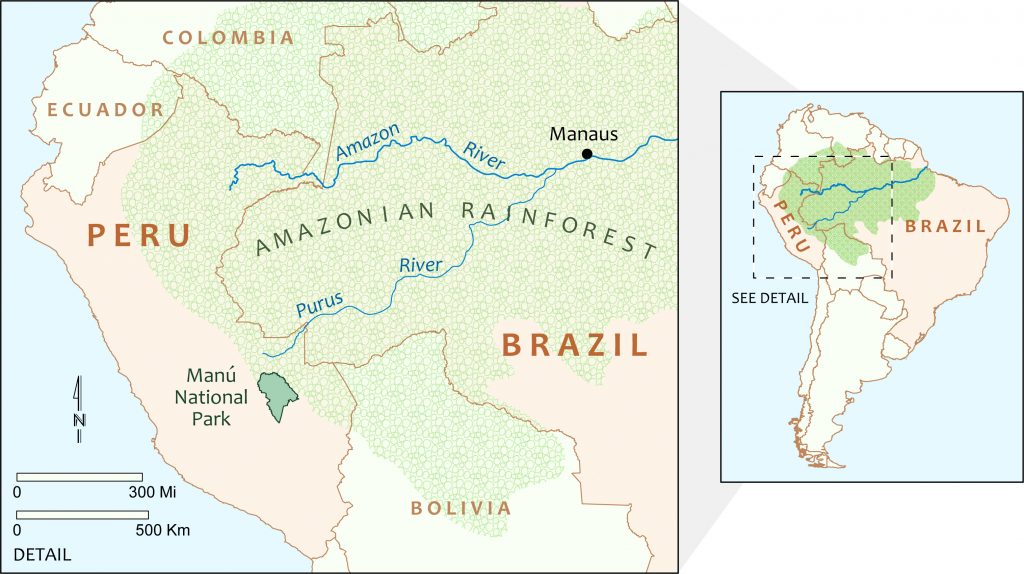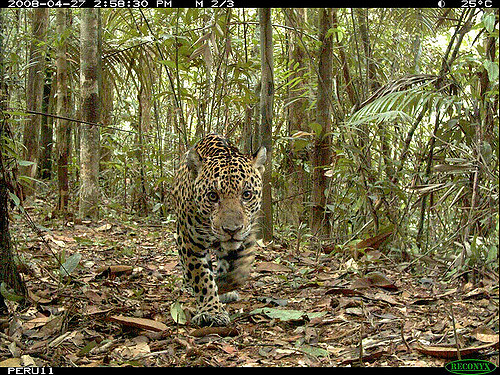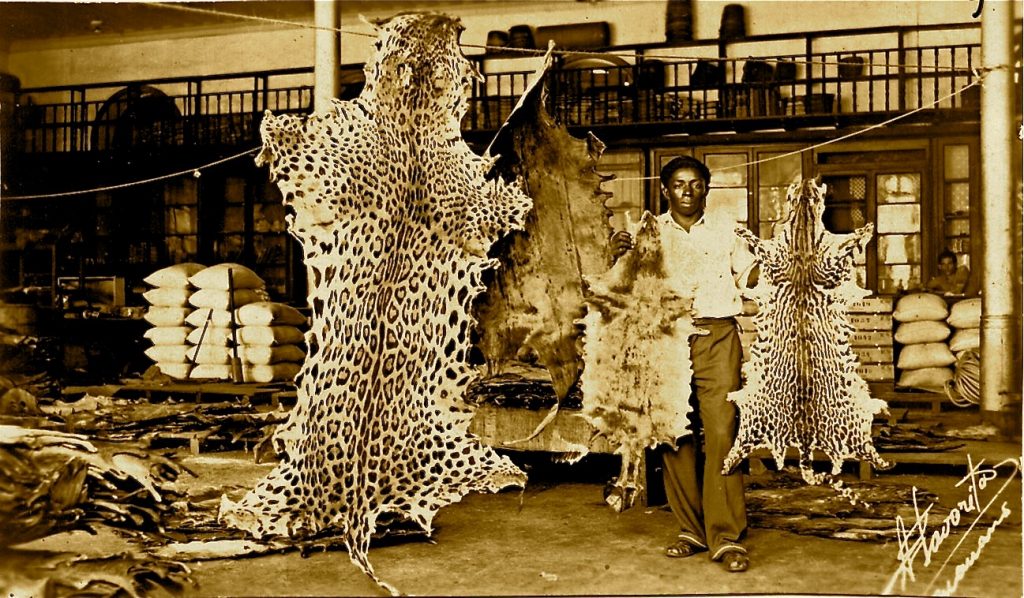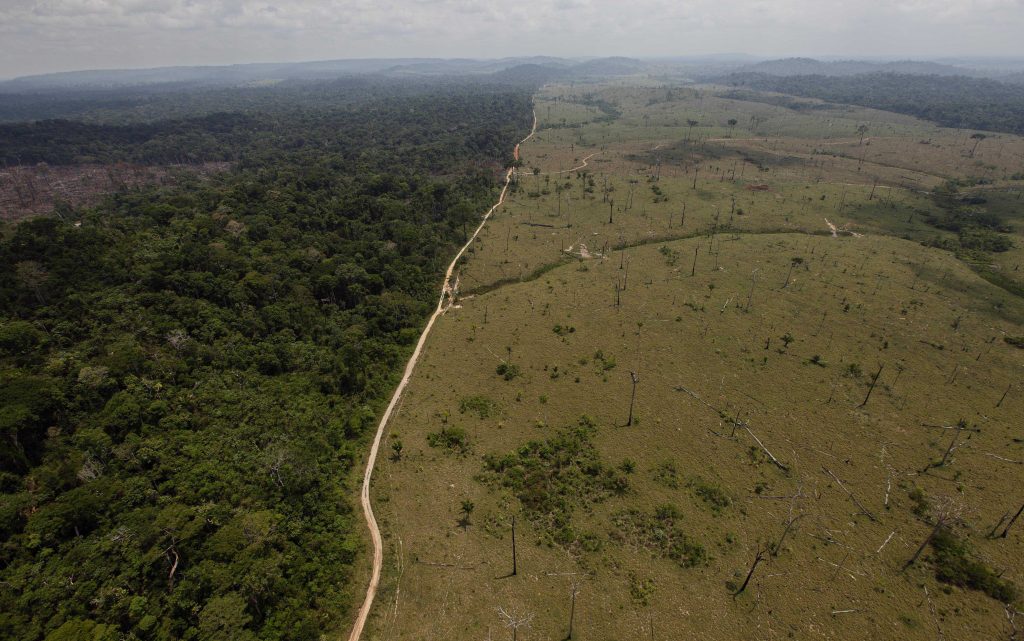Lessons From a Forgotten Amazonian Slaughter
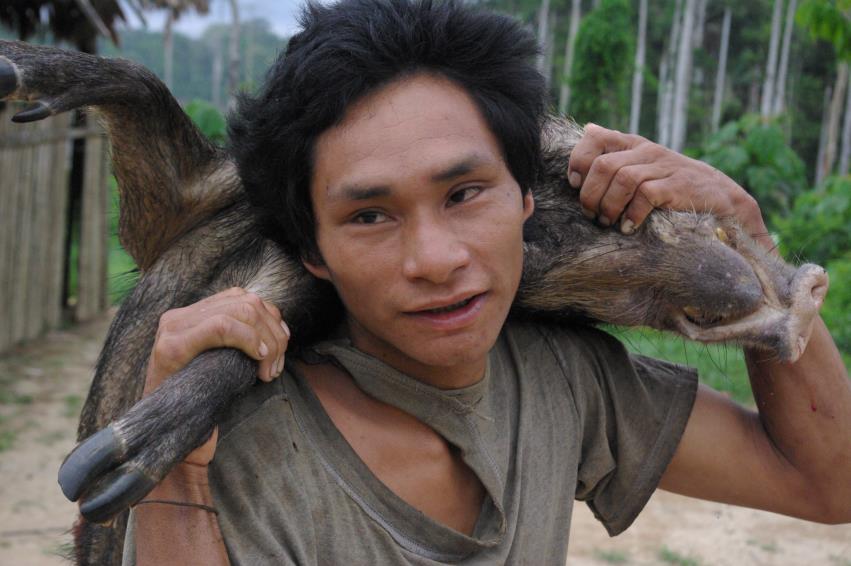
Francisco Evangelista, a Paumari Indian who grew up along the Piranha River within the Purus River basin in the Brazilian Amazon, tells a tale from his boyhood about a pelt hunter who went mad from his own excess. Speaking in backwoods Portuguese, Evangelista—who was raised by a rubber tapper whom he called patrão (“boss”)—recalls the day he and the patrão came upon this commercial hunter in distress.
“My boss found [the pelt hunter] on the river bank by a whole herd he had just killed, must have been 12 or 15 peccaries skinned and left to rot,” Evangelista recounts. “We had seen two more herds he had slaughtered a little farther up the river. He was crazy, scared, shaking, screaming about how the jaguars and peccaries were coming to get him because he had killed so many. We took him in our boat but he kept screaming and going crazier and crazier till finally he died, right in front of my eyes,” Evangelista says. “Our people know you can’t just go killing animals like that. It’s perverse. And the forest has its guardians.”
Hunting by local forest-dwelling people in the Amazon for subsistence and commercial purposes has long been considered by many conservationists to be a major threat to biodiversity conservation. In the 1990s, conservationists warned that unbridled hunting could result in “empty forests”—places where trees remain but large animals are eerily absent, hunted out by local people. A 2016 modeling projection study suggests that overhunting could wipe out primates and other animals that act as seed dispersers, reducing the regrowth of large trees and vastly reducing carbon stocks in the long term. But data sets based on commercial hunting booms throughout the 20th century tell a different story, showing that many terrestrial Amazonian species have proven more resilient than most experts expected.
We—Glenn Shepard, an anthropologist who has lived for long periods with Indigenous Amazonians and studied their hunting patterns, and Emma Marris, a journalist who met Shepard on assignment for National Geographic—have collaborated to highlight this resilience and shed light on the deeper complexities of subsistence hunting and sustainability.
Evangelista recounted his childhood story about the pelt hunter to André Pinassi Antunes, a Brazilian biologist with the Wildlife Conservation Society, who was doing research on hunting in the region. Antunes began his research in March 2008, collecting data on the species and numbers of animals hunted by local people in the Purus River basin in Brazil’s Amazonas State for the Piagaçu Institute, a local socio-environmental research center.
During Antunes’ fieldwork, he set “camera traps” to document the local species, walked transects in the forest counting animals, and monitored hunters’ takes to get a handle on how many animals were being killed. But along the way, he heard stories about the commercial hunting booms from elderly Indigenous and non-Indigenous people who had witnessed the wholesale massacre of jaguars, peccaries, otters, caiman, and other animals for the international fur and skin trade that lasted from the 1920s through the 1970s. He realized that without taking large-scale commercial hunting into consideration, his studies had no historical context.
An elderly hunter named Dico Gomes told Antunes that back in the 1960s and ’70s, the commercial hunters nearly eradicated the animals and wasted a great deal of meat. “They would kill animals for their skin and leave the rest to rot and be eaten by vultures or piranhas,” Gomes recalls. “We used to kill a few peccaries to eat and then sell their hides, but these professional hunters really wiped out the animals. You could barely find anything to hunt back then. These days it’s much better—there are animals everywhere.”
It became clear to Antunes that during this historical period, commercial hunting rates were more intense than the rates of subsistence hunting he was recording. Commercial hunters only carried out the skins, not the entire animals, so they took more animals on a single trip than subsistence hunters. And among the animals they targeted were predators with pretty fur, like ocelots and jaguars, which the local people otherwise only killed occasionally—when in danger or to protect livestock.
After Antunes finished up his first stint of fieldwork in May of 2008 and returned to the regional metropolis of Manaus, he began to dig through local historical archives in the hopes of finding shipping records that would provide concrete evidence of the impacts of this bygone fur trade. In the Amazonian Museum of the Federal University of Amazonas, he found a trove of previously inaccessible shipping and business records from the Manaus-based commercial empire of Joaquim Gonçalves (“J.G.”) Araujo, a colorful rubber-era tycoon whose family had donated his papers to the museum. Araujo had commanded a vast fleet of vessels throughout the western Amazon and exported rubber—and later animal skins—to markets around the globe. Antunes and six co-authors, including Shepard, analyzed the Araujo documents and other long-forgotten commercial data on Amazon pelt hunting. They published their results in October 2016 in Science Advances.
The study estimates that between 1904 and 1969, at least 23 million animals representing 20 species of mammals and reptiles were commercially hunted for hide export in the central-western Brazilian Amazon. During the heyday of the fur trade from the 1930s to the late 1960s, the most valued species accounted for at least US$500 million (adjusted to 2015 dollars) in export trade. These figures are almost certainly underestimates due to underreporting of exports to avoid taxes. In addition, many animals would have been fatally wounded in the course of hunting, and substandard hides were probably discarded before reaching port. Among the animal species that were hunted most heavily were the collared and white-lipped peccaries (boar-like species native to Central and South America); the red brocket deer; and the black caiman. Comparing these figures to subsistence hunting is no easy task, in part because the sources of the data are so different and also because available studies cover different geographical areas. Nevertheless, Antunes and his colleagues guess that per capita hunting pressure was around two to three times higher in the late 1930s (commercial hunting) than in the 1990s (subsistence hunting).
Export numbers fluctuated over time, driven by international market forces. During the so-called “rubber boom,” which peaked from the late 1890s through 1912, Amazonian businessmen like Araujo used their monopoly on export markets and remote forest supply lines to exploit rubber tappers in a debt peonage regime known as aviamento. After 1912, Malaysian rubber plantations opened up and drove down the price of rubber. One coping strategy for South American enterprises was to expand into pelts.
Thus began a new, grim era for the forest and its animals. The international trade in Amazonian animal hides gradually increased after 1912, then experienced its first peak during World War II when the U.S. again sought wild rubber from the Brazilian Amazon—this time after the capture of Malaysian rubber plantations by the Japanese. The influx of tens of thousands of rubber tappers meant more hunters in the forest taking advantage of a secondary income stream. The 1960s saw a second peak of Amazonian animal hide exports as exotic furs came into fashion in Europe and the United States. The suit worn by Catwoman in the 1966 film Batman: The Movie helped drive the trend. When not sprinting around in her leather action suit, Catwoman wore a stylish jacket and toque in jaguar fur. Jacqueline Kennedy and Elizabeth Taylor also wore exotic spotted furs in the early part of the decade.
Brazil officially banned all hunting (except in cases of “survival”) in 1967 to stem the slaughter of wild animals. But loopholes in the legislation that allowed for the sale of “warehoused” hides meant that illegal hunting and hide exports continued unchecked until the Convention on International Trade in Endangered Species of Wild Fauna and Flora (CITES) was ratified in 1975. Demand for exotic furs continued to drive some illegal trade through the 1980s, and it was only with the U.N.’s 1992 Conference on Environment and Development (or “Earth Summit”) and the Convention on Biological Diversity that international opinion largely turned against the use of wild animal furs in fashion.
Given the huge quantities of furs that commercial hunting extracted from the forest, Antunes expected to find that populations of hunted species had taken a hit. In their 2016 study, Antunes and his colleagues compared peak hide exports for each species in the 1930s and ’40s with the second peak of hide exports in the ’60s. Their hypothesis was that if animal populations were substantially reduced by the first surge, during WWII, records would show reduced exports during the next period of high demand roughly two decades later. With the exception of the white-lipped peccary, though, the “empty forest” scenario that some experts predicted was not borne out by the historical data. Terrestrial mammals—even top predators like the jaguar, which are typically fewer in number and more vulnerable to overhunting—showed little or no decline in exports despite intense commercial hunting pressure over many decades.
The white-lipped peccary was the only terrestrial animal that showed declining harvests through time, with a 67 percent drop between the 1937–1943 boom and the post-1965 boom. A social animal, it travels in groups and is more susceptible to mass slaughter and herd diseases, and will thus require special attention and conservation strategies if it is to remain an important part of traditional forest peoples’ diets.
But apart from the white-lipped peccary, terrestrial animal populations were surprisingly resilient in the face of all that hunting. In contrast, aquatic species like the giant river otter, black caiman, and manatee showed rapidly dwindling export numbers during the age of commercial hunting, despite steadily rising prices—proof that their population had collapsed under hunting pressure. The result was local extinction in aquatic and semiaquatic habitats—an “empty river” scenario.
Why were most terrestrial Amazonian species so resilient to commercial hunting pressures throughout the 20th century? The answer is the relative inaccessibility of their habitat to hunters. Whereas aquatic environments during the high-water season are more easily available to hunters (who typically travel by boat in the forest) and make up only 12 percent of the surface area, upland forest areas are much larger and more difficult to reach. Even during commercial hunting’s most intense years, there were vast and numerous unhunted areas that provided refuge for a variety of terrestrial animals—even those that were heavily hunted. These refuges were places where animals could persist and reproduce. When hunting pressure declined, wildlife could expand outward from these areas and repopulate regions that were overhunted.
This process is best understood through the lens of “source/sink dynamics.” The unhunted areas were the “source” of replacement animals that moved to the “sink” zone where hunting had reduced their numbers. These dynamics are still in play in those parts of the Amazon with large and numerous unhunted areas, suggesting that these areas can support ongoing subsistence hunting pressure. In prior work, Shepard and his colleagues have shown how traditional scientific measures of hunting impacts have underestimated game animal resilience and also failed to predict the long-term impacts of hunting through space and time. In part, the failure of earlier models can be chalked up to the failure to account for source/sink dynamics. Prey is not spread out evenly in the forest at a standard and static density; animals migrate and reclaim territories left vacant by animals that have been killed.
The more advanced models proposed by Shepard and colleagues built on earlier work led by Taal Levi, a mathematical ecologist who is now at Oregon State University. Levi created a computer model of hunting patterns in Manú National Park in the Peruvian Amazon and projected it forward 50 years. In all scenarios, and even given robust human population growth, the model suggests that hunting does remain sustainable—even of highly vulnerable species like the spider monkey—thanks to the existence of large unhunted areas and the park’s prohibitions against hunting with guns. (Indigenous hunters there still use bows and arrows, which is fiendishly difficult). The model shows that even if Indigenous hunters in Manú were to switch to guns (currently prohibited by park policy), areas close to the villages would be emptied of spider monkey populations but distant, unhunted populations would continue to repopulate these “sink” areas.
Brazil’s 1967 blanket ban on hunting wild animals did include an exception for “hunting for survival”—but no definition of what that means in practice. Thus hunting, a crucial traditional practice that provides nutritionally valuable protein for the Amazon’s forest peoples, continues to occupy a dubious legal status. As a result, forest dwellers are left vulnerable to the whims of local fish and wildlife officials who determine whether a given game animal is necessary for survival or not. If the officials suspect a hunter is going to sell the game, they can confiscate it and the hunter’s weapon, as well as demand a fine.
There are some attempts to codify subsistence hunting, most notably the creation of forest zones designated for “sustainable use” that allow local people to come up with their own management plans. The community may informally agree, for example, that “you can’t shoot female agoutis during the reproductive season” or that “you can’t hunt anything in this river for two years.” In other cases, people may avoid eating certain species because of their strong odors, spiritual dangers, or health hazards. Such food taboos and other local rules, based on people’s long familiarity with their home ecosystems, act as a kind of local-level conservation system. Some rules are based on long-held traditional beliefs, others have been negotiated in consultation with biologists like Antunes. These community rules are widely regarded as effective by biologists. However, such variable local rules are not easy to translate into more cohesive, regional policies, and many forest peoples hunt in gray zones of legality with little regulation.
Official conservation policies need to take into consideration local peoples’ variable traditional patterns of hunting, which are informed by beliefs and practices that contribute to sustainability. And these policies should also incorporate scientific research that considers the ongoing sustainability of these critical food sources. Such an approach would allow for a mosaic of reserve types—some open to controlled hunting, others not. More broadly, we suggest that the reinforcement of forest peoples’ land rights through local hunting management could help stop the fragmentation of intact forest cover by roads and other large-scale development projects that indeed threaten to leave an “empty forest.” Mining and hydroelectric development are currently not permitted on indigenous reserves in Brazil; however, recent political developments have strengthened the hand of the extractive and agribusiness industries to the potential detriment of forest peoples and the resources and territories they depend on for survival.
Kent Redford, author of the original “empty forests” paper, and now a conservation consultant in Portland, Maine, says hunting remains a major issue in tropical forests worldwide, and that commercial hunting is often more intense and damaging than subsistence hunting. But, Redford says, every situation has its own dynamics—its own geography, politics, hunting technologies, and ecology of hunted species. As we learned from Antunes’ work, terrestrial and freshwater hunting have markedly different dynamics, for example. “Hunting issues tend to be generalized by people,” Redford told us, “but actually they aren’t generalizable.” So he’s happy to consider that subsistence hunting by certain groups, under certain conditions, and for certain species might be sustainable. “It all depends,” Redford says. Even hunting blue whales could be “sustainable” if you only killed one every 100 years.
The commercial hunter who was undone by his own death-dealing sensed something profound about killing wild animals. An act that can be culturally affirming and supportive of health and well-being on a small scale becomes something completely different, something potentially ruinous, when practiced at a large scale. The excess carcasses left steaming and rotting in the jungle heat were white-lipped peccaries—the one terrestrial species that saw a permanent reduction after the first commercial boom.
The trick is to find the line between what is sustainable and unsustainable. Mathematical modeling can help—clarifying patterns of hunting impacts through space and time, revealing the need for stricter rules to protect river species, for example. There are also answers hidden in dusty boxes from defunct shipping companies, as well as in hunting data gathered in the field. But traditional knowledge and wisdom should also be part of the solution: hunting seasons, no-take zones, taboos, cultural prohibitions, and an attitude of respect. The guardians of the forest have their answers too.





























